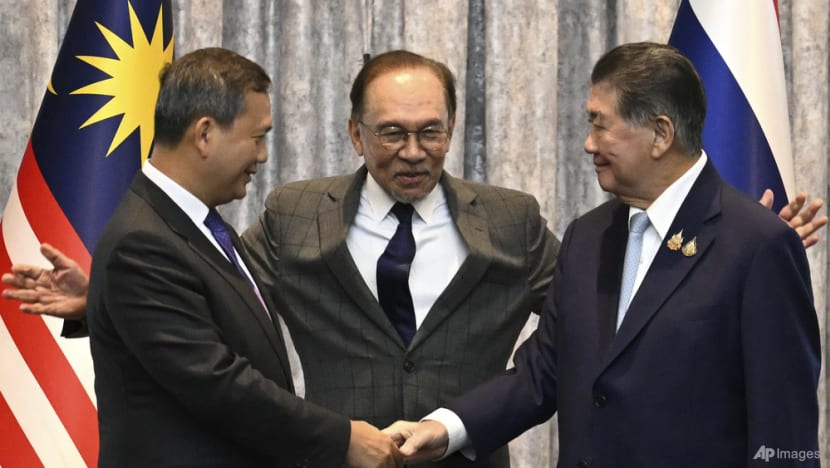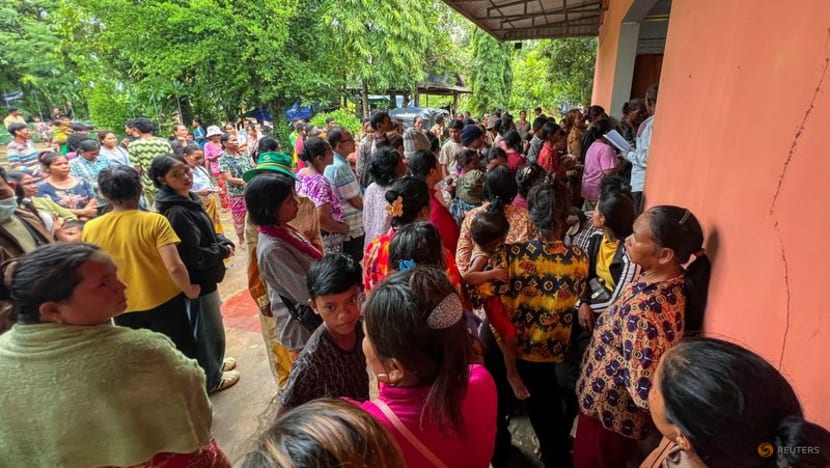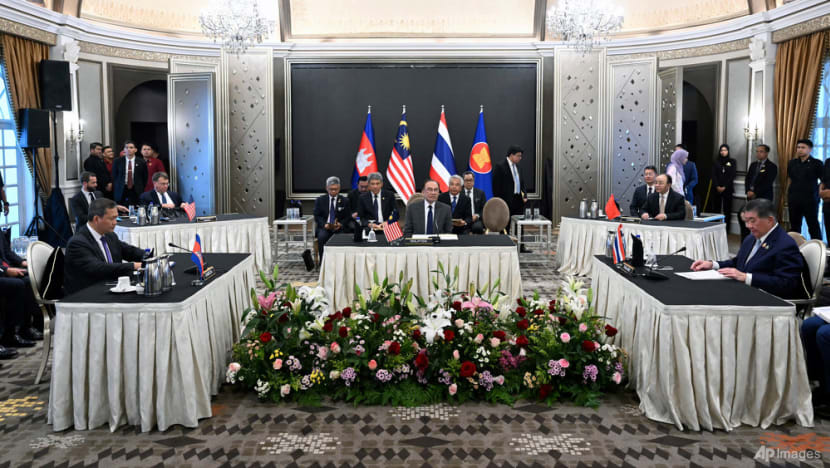analysis Asia
Thai-Cambodia ceasefire: ‘Rare diplomatic success’ due to Anwar, ASEAN and US pressure
The ceasefire agreement brokered in Putrajaya was a win for Malaysia premier Anwar Ibrahim and ASEAN, experts say. With clashes reportedly erupting early Tuesday morning, however, observation teams are urgently needed on the ground.


This audio is generated by an AI tool.
KUALA LUMPUR: The carrot of trade negotiations from United States President Donald Trump, Malaysian Prime Minister Anwar Ibrahim’s leadership and the provision of a “face-saving” platform for Thailand and Cambodia to conduct peace talks helped achieve a fragile ceasefire that began at the stroke of midnight on Tuesday (Jul 29), analysts told CNA.
It is too early to tell if the ceasefire will hold, but with Thailand accusing Cambodia of armed attacks on Tuesday morning – which Cambodia has denied – there is now an urgent need to deploy observation teams on the ground, the experts added.
They also said reports of some skirmishes hours after the truce came into effect are not surprising, and that the deal is a “coup” for the Association of Southeast Asian Nations (ASEAN) and Anwar.
Border tensions between the two Southeast Asian neighbours escalated last Thursday into a deadly conflict that has killed at least 38 people and displaced hundreds of thousands in both countries.
On Monday, Thai Acting Prime Minister Phumtham Wechayachai and Cambodian Prime Minister Hun Manet agreed to an unconditional ceasefire after talks in Putrajaya chaired by Anwar, who is this year’s ASEAN chair.
The special meeting was co-organised by the US with the “active participation” of China, according to a joint press release issued after the event.
Both sides' regional commanders were also due to meet on Tuesday morning, and this could be followed by a meeting with both countries’ defence attaches led by the ASEAN chair, according to the press release.
A spokesperson from the Thai army said on Tuesday its Army Region 1 (Trat and Chanthaburi) has met with Cambodian counterparts.
Its Army Region 2, which covers the Isaan region including the four provinces affected by clashes, is still setting up a date with Cambodian counterparts.
The border situation was calm on Tuesday, with Phumtham saying "there is no escalation," and Cambodia's defence ministry spokeswoman Maly Socheata adding earlier that there had been "no armed clashes against each other in any regions".

WHAT CEASEFIRE MEANS FOR ASEAN – AND ANWAR?
Some analysts have dubbed the ceasefire agreement a “rare diplomatic success” for ASEAN.
It reinforces the bloc’s relevance in managing intra-regional crises, said Jamil Ghani, a doctoral candidate at Singapore’s S Rajaratnam School of International Studies.
“It revives confidence in ASEAN centrality and showcases the bloc’s potential to uphold its founding commitments to regional peace, neutrality, and non-interference … The swift resolution also strengthens ASEAN’s credibility as a framework for conflict mediation without great-power involvement,” he said.
“Amid mounting criticism over ASEAN’s inertia on issues like Myanmar, the Cambodia-Thailand ceasefire illustrates that the bloc can still deliver meaningful outcomes — when its chair acts decisively,” said Jamil.
Anwar had acted quickly and displayed his diplomatic skills in brokering the ceasefire, analysts agreed.
He offered a neutral venue and framed the talks under ASEAN’s diplomatic umbrella, giving both parties “political space to de-escalate”, noted Jamil.
“To save face, neither Thailand nor Cambodia would have acted to stop first, so Malaysia stepped in as mediator. Malaysia understands the predicament of Thailand and Cambodia and that is a starting point to end the conflict,” said Nusantara Academy for Strategic Research senior fellow Azmi Hassan.
While a “coup” for Malaysia and ASEAN, Azmi and other experts noted US President Trump’s role in nudging both sides towards peace.
Both Cambodia and Thailand currently face a 36 per cent tariff on goods exported to the US, which is set to take effect from Aug 1, unless a reduction can be negotiated.
“Trump had linked tariff talks to a ceasefire. For all the talk about China, it seems that these states still can’t do without the US market. ASEAN on its own was unable to broker a meeting earlier or to prevent the conflict from breaking out,” said Chong Ja Ian, an assistant professor of political science at the National University of Singapore (NUS).
US Ambassador Edgard Kagan and Chinese Ambassador Ouyang Yujing were present during the meeting in Putrajaya.
Trump on Monday claimed that both countries reached a ceasefire and peace because of his involvement, and said trade negotiations would resume.
“By ending this war, we have saved thousands of lives. I have instructed my trade team to restart negotiations on trade. I have now ended many wars in just six months — I am proud to be the President of peace!” he said on the Truth Social platform.
Chinese Foreign Minister Wang Yi called for calm last Friday during talks with ASEAN Secretary-General Kao Kim Hourn in Beijing.
In his separate meetings with Thai Foreign Minister Maris Sangiampongsa and Cambodian Deputy Prime Minister and Minister of Foreign Affairs and International Cooperation Prak Sokhonn earlier this month, Wang had expressed hope that the two neighbours will uphold peace and resolve their dispute through dialogue.
China will play an impartial and constructive role on the matter, Wang added.
On Sunday, a Chinese Foreign Ministry spokesperson said Cambodia and Thailand are important members of ASEAN which has been "working intensively" to bring about a ceasefire.
"China commends it and welcomes all efforts conducive to de-escalation. China will maintain its fair and impartial position and continue having close communication with both sides, actively facilitate talks for peace and play a constructive role for a ceasefire.”
Anwar himself called the agreement “concrete evidence of ASEAN’s diplomatic strength” and said the 10-member bloc “remains united and principled”.
It was the alignment of multiple factors - including pressure from the US and China - that led to the announcement of the ceasefire, said retired Malaysian ambassador Ilango Karuppannan.
For Anwar, the ceasefire success is both symbolic and strategic, coming days after thousands of Malaysians took to the streets to protest rising living costs and a perceived lack of reform by his unity government, marking the first major protest since he came to power in 2022.
“Domestically, it provides a high-profile foreign policy achievement during Malaysia’s ASEAN chairmanship — one that can strengthen his government’s standing and enhance Malaysia’s diplomatic profile,” Jamil said.
While it boosts his international image, “whether that helps his domestic situation is yet to be seen”, said Ilango.

GROUND MONITORING NOW NEEDED
However, with the spectre of one or both sides reneging on the ceasefire, experts said there is an immediate need for a monitoring and observation team.
It is common to see remnants of fighting as local commanders may not have all received the orders, said Ilango.
“Sometimes, it’s simple things like (the) lack of walkie talkies. Sometimes, a soldier wants revenge for his friends’ death,” he said.
“So what can the three governments do? The first is to deploy the ceasefire monitoring or observation mission immediately. It must go to the ground and not just go to the capitals for briefings,” he added.
Even with an agreement in place, one or both sides could always renege on it, noted Chong.
“There is presently no mechanism in place to restrain their behaviour. Tensions, suspicions, tempers and animosity continue to run high. Ultimately, the two sides need to move troops away from each other to avoid rapid escalation and allow negotiations to prevail,” he said.

The latest reports of clashes, he said, suggests the “real limits to what ASEAN and other actors can do” if they are not utilising political capital to get the two sides to stop the hostilities.
“If ASEAN wishes to be more active, it could offer observers on the ground to monitor phased withdrawals by both sides and provide transparency to avoid misunderstanding or miscalculation by the Thai and Cambodian sides on the ground,” Chong said.
Chong said ASEAN could theoretically work with the United Nations (UN) or offer its own peacekeepers to keep the two sides apart.
But this would be challenging, he said, as it could involve putting personnel from other ASEAN states in the middle of tensions, or suggest that ASEAN is unable to act on its own if other actors are called in. “This option does not appear to be on the table right now,” Chong noted.
Malaysia could also try to convene further talks between Cambodia and Thailand in the hopes that this could bring more stability to the relationship, he added.
The joint statement after the Putrajaya talks had stated that direct communications between the prime ministers, foreign and defence ministers of Cambodia and Thailand will resume.

















